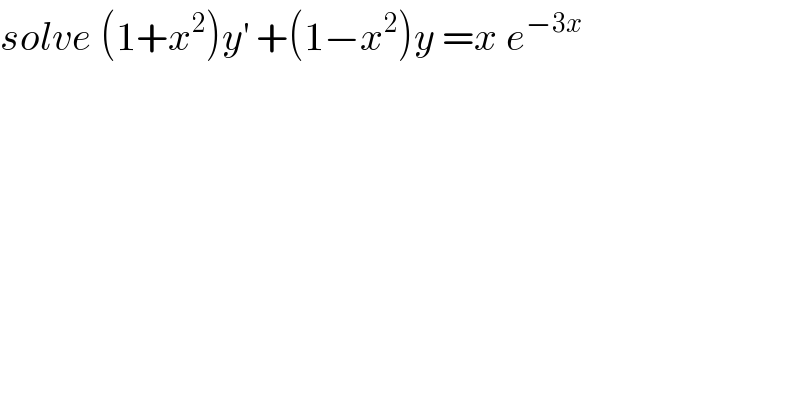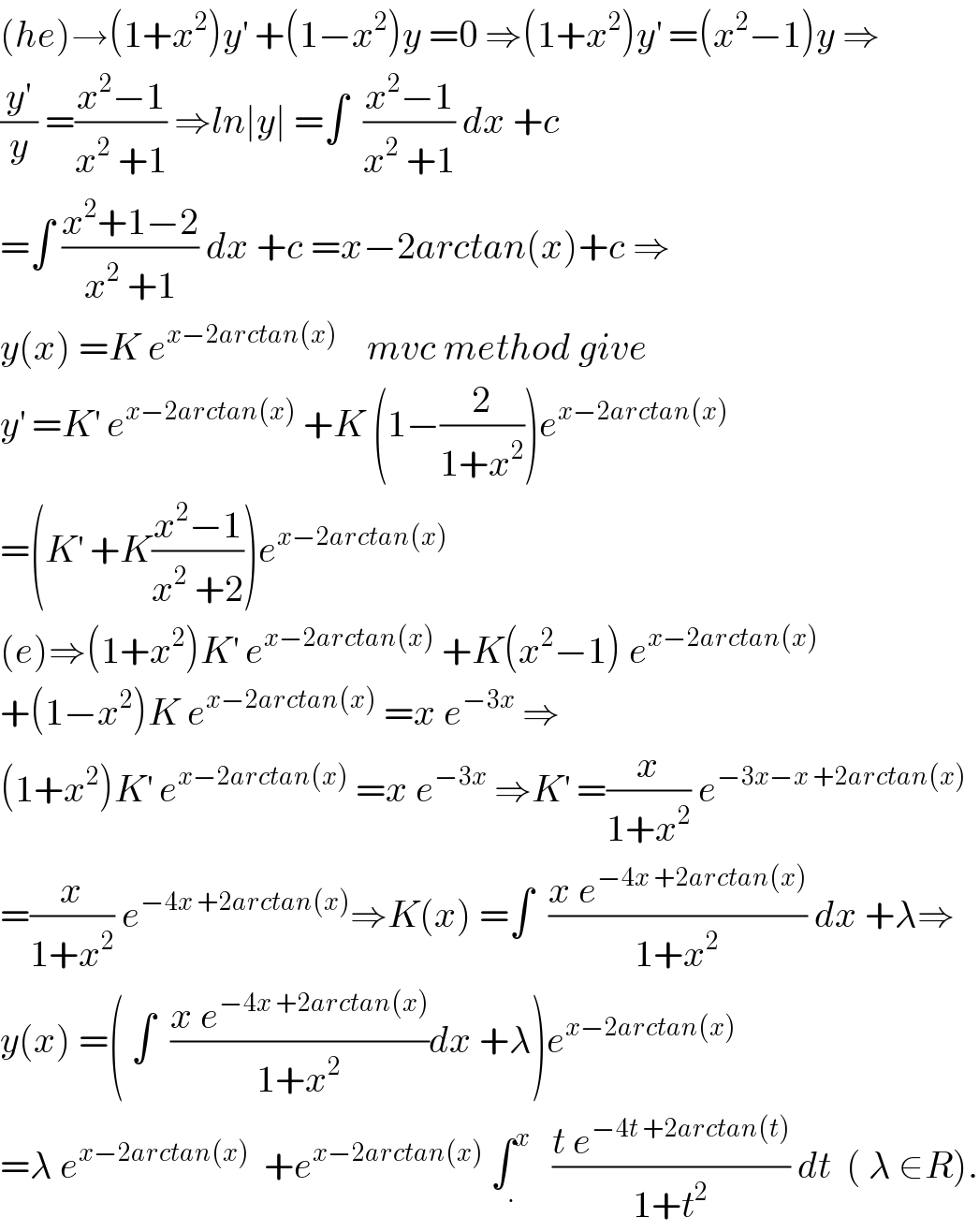Question Number 61178 by mathsolverby Abdo last updated on 30/May/19

$${solve}\:\left(\mathrm{1}+{x}^{\mathrm{2}} \right){y}^{'} \:+\left(\mathrm{1}−{x}^{\mathrm{2}} \right){y}\:={x}\:{e}^{−\mathrm{3}{x}} \\ $$
Commented by maxmathsup by imad last updated on 31/May/19

$$\left({he}\right)\rightarrow\left(\mathrm{1}+{x}^{\mathrm{2}} \right){y}^{'} \:+\left(\mathrm{1}−{x}^{\mathrm{2}} \right){y}\:=\mathrm{0}\:\Rightarrow\left(\mathrm{1}+{x}^{\mathrm{2}} \right){y}^{'} \:=\left({x}^{\mathrm{2}} −\mathrm{1}\right){y}\:\Rightarrow \\ $$$$\frac{{y}^{'} }{{y}}\:=\frac{{x}^{\mathrm{2}} −\mathrm{1}}{{x}^{\mathrm{2}} \:+\mathrm{1}}\:\Rightarrow{ln}\mid{y}\mid\:=\int\:\:\frac{{x}^{\mathrm{2}} −\mathrm{1}}{{x}^{\mathrm{2}} \:+\mathrm{1}}\:{dx}\:+{c} \\ $$$$=\int\:\frac{{x}^{\mathrm{2}} +\mathrm{1}−\mathrm{2}}{{x}^{\mathrm{2}} \:+\mathrm{1}}\:{dx}\:+{c}\:={x}−\mathrm{2}{arctan}\left({x}\right)+{c}\:\Rightarrow \\ $$$${y}\left({x}\right)\:={K}\:{e}^{{x}−\mathrm{2}{arctan}\left({x}\right)} \:\:\:\:{mvc}\:{method}\:{give} \\ $$$${y}^{'} \:={K}^{'} \:{e}^{{x}−\mathrm{2}{arctan}\left({x}\right)} \:+{K}\:\left(\mathrm{1}−\frac{\mathrm{2}}{\mathrm{1}+{x}^{\mathrm{2}} }\right){e}^{{x}−\mathrm{2}{arctan}\left({x}\right)} \\ $$$$=\left({K}^{'} \:+{K}\frac{{x}^{\mathrm{2}} −\mathrm{1}}{{x}^{\mathrm{2}} \:+\mathrm{2}}\right){e}^{{x}−\mathrm{2}{arctan}\left({x}\right)} \\ $$$$\left({e}\right)\Rightarrow\left(\mathrm{1}+{x}^{\mathrm{2}} \right){K}^{'} \:{e}^{{x}−\mathrm{2}{arctan}\left({x}\right)} \:+{K}\left({x}^{\mathrm{2}} −\mathrm{1}\right)\:{e}^{{x}−\mathrm{2}{arctan}\left({x}\right)} \\ $$$$+\left(\mathrm{1}−{x}^{\mathrm{2}} \right){K}\:{e}^{{x}−\mathrm{2}{arctan}\left({x}\right)} \:={x}\:{e}^{−\mathrm{3}{x}} \:\Rightarrow \\ $$$$\left(\mathrm{1}+{x}^{\mathrm{2}} \right){K}^{'} \:{e}^{{x}−\mathrm{2}{arctan}\left({x}\right)} \:={x}\:{e}^{−\mathrm{3}{x}} \:\Rightarrow{K}^{'} \:=\frac{{x}}{\mathrm{1}+{x}^{\mathrm{2}} }\:{e}^{−\mathrm{3}{x}−{x}\:+\mathrm{2}{arctan}\left({x}\right)} \\ $$$$=\frac{{x}}{\mathrm{1}+{x}^{\mathrm{2}} }\:{e}^{−\mathrm{4}{x}\:+\mathrm{2}{arctan}\left({x}\right)} \Rightarrow{K}\left({x}\right)\:=\int\:\:\frac{{x}\:{e}^{−\mathrm{4}{x}\:+\mathrm{2}{arctan}\left({x}\right)} }{\mathrm{1}+{x}^{\mathrm{2}} }\:{dx}\:+\lambda\Rightarrow \\ $$$${y}\left({x}\right)\:=\left(\:\int\:\:\frac{{x}\:{e}^{−\mathrm{4}{x}\:+\mathrm{2}{arctan}\left({x}\right)} }{\mathrm{1}+{x}^{\mathrm{2}} }{dx}\:+\lambda\right){e}^{{x}−\mathrm{2}{arctan}\left({x}\right)} \\ $$$$=\lambda\:{e}^{{x}−\mathrm{2}{arctan}\left({x}\right)} \:\:+{e}^{{x}−\mathrm{2}{arctan}\left({x}\right)} \:\int_{.} ^{{x}} \:\:\:\frac{{t}\:{e}^{−\mathrm{4}{t}\:+\mathrm{2}{arctan}\left({t}\right)} }{\mathrm{1}+{t}^{\mathrm{2}} }\:{dt}\:\:\left(\:\lambda\:\in{R}\right). \\ $$
